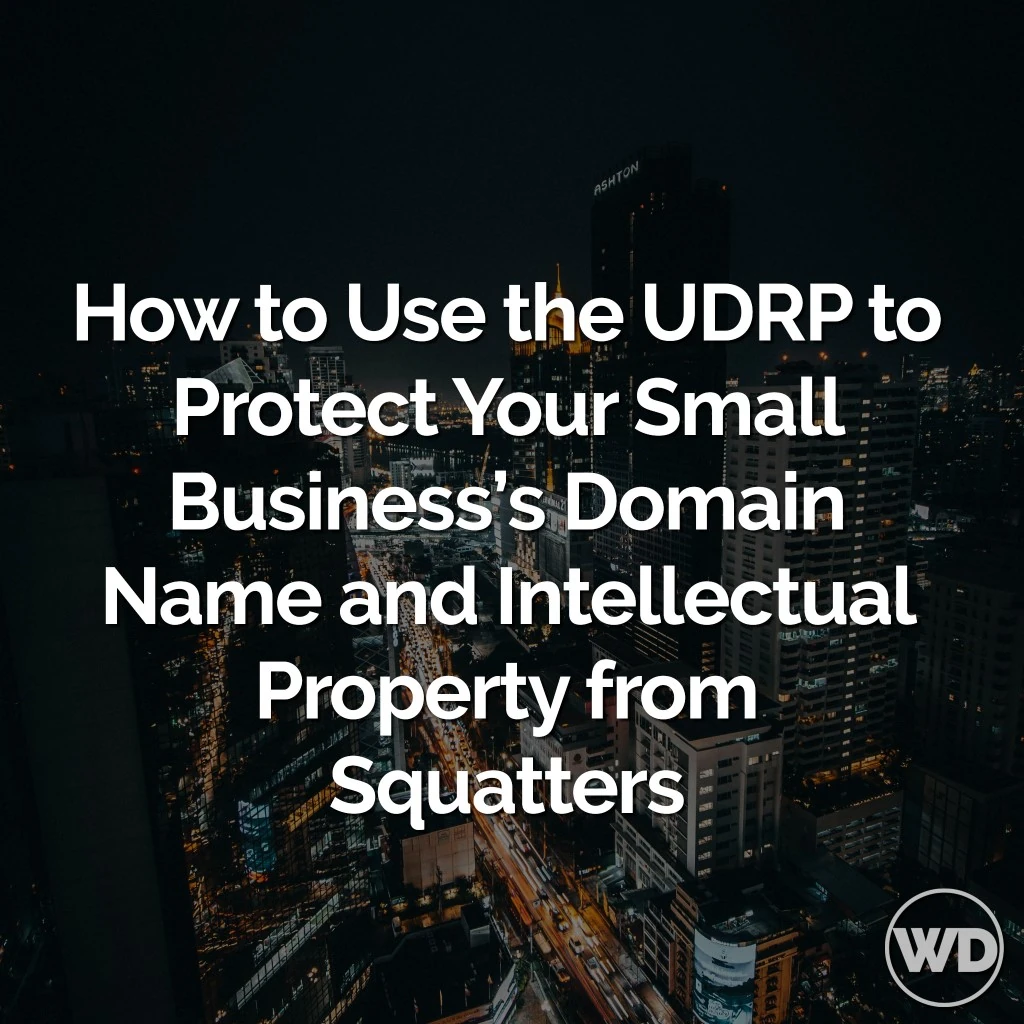Introduction: Why Small Businesses Need to Know About the UDRP
As a small business owner, you’ve worked hard to build your brand, establish your online presence, and create something valuable. But what happens when someone buys up a domain name that’s confusingly similar to yours, potentially steering your customers in the wrong direction? Or worse—when they demand a hefty price to hand over a domain name that rightfully aligns with your brand? This is where the Uniform Domain-Name Dispute-Resolution Policy (UDRP) can be your best friend.
The UDRP is an international dispute resolution process designed to help trademark holders (like you) resolve domain name disputes without going through lengthy and expensive lawsuits. In this article, we’ll walk you through everything you need to know to understand the UDRP process, protect your brand’s intellectual property, and take action against domain squatters. Even if hiring an attorney is recommended, this guide will help you understand the process from a small business owner’s perspective.
S01-E015
How to Use the UDRP to Protect Your Small Business
Listen to this article as a fast 10-minute podcast.
What is the UDRP and Why Should Small Business Owners Care?
The Uniform Domain-Name Dispute-Resolution Policy (UDRP) is an international policy developed by ICANN (Internet Corporation for Assigned Names and Numbers) to resolve disputes over domain names outside of traditional court systems. The UDRP is commonly used by businesses to take action against cybersquatting, also known as domain squatting. This is when someone registers, uses, or tries to sell a domain name that’s confusingly similar to your business’s name or trademark, often with the intent of making a profit by reselling it to you.
For small business owners, the UDRP is essential because:
- It provides an affordable and efficient way to resolve domain name disputes.
- It can help you gain control over a domain name that rightfully aligns with your brand.
- It protects your online reputation by preventing others from using similar names to confuse or mislead your customers.
Now, let’s break down how the UDRP works and what you need to do to file a successful UDRP claim.
Understanding How Domain Squatting Works
Domain squatting is when someone registers a domain name that’s identical or confusingly similar to your trademark, business name, or domain name with the intent of profiting from your brand. Domain squatters often target popular names, brandable domains, and those that are easily confused with existing trademarks.
Here’s how domain squatters operate:
- They register a domain similar to your business (e.g., yourbusiness.com) and hope you’ll pay a high price to obtain it.
- They might use the domain to display ads, redirect traffic to competitors, or even create a fake site to exploit your brand’s reputation.
- In some cases, they’ll register multiple variations of your brand’s name to increase confusion and demand.
These tactics can hurt your brand, confuse customers, and ultimately take a toll on your bottom line. With the UDRP, you have a way to fight back.
How the UDRP Process Works: A Step-by-Step Guide for Small Businesses
The UDRP process is straightforward, but it requires you to present a solid case. Here’s how it works:
Step 1: Check if You Qualify to File a UDRP Claim
Before filing, make sure your situation meets the UDRP’s criteria. A successful UDRP complaint must prove three things:
- The domain name is identical or confusingly similar to your trademark or brand.
- The domain holder (the squatter) has no legitimate rights or interests in the domain.
- The domain was registered and is being used in bad faith.
If you can satisfy all three criteria, you’re ready to proceed.
Step 2: Document Evidence of Your Trademark and Domain Rights
Documentation is key to a successful UDRP case. Gather evidence to support your complaint, such as:
- Trademark registrations: If your business name or logo is trademarked, include copies of these registrations.
- Domain registration: Document when you registered your original domain name (if applicable) to show your prior use.
- Proof of brand recognition: Collect materials that demonstrate your brand’s reputation, such as website traffic data, social media profiles, or customer reviews.
While you don’t legally need a registered trademark to file a UDRP claim, having one makes your case stronger.
Step 3: Show Evidence of Bad Faith
To win a UDRP case, you’ll need to show that the squatter registered the domain in bad faith. Common indicators of bad faith include:
- The domain owner is offering to sell the domain to you or other competitors at an inflated price.
- The domain is being used to redirect traffic to competitors or irrelevant sites.
- The domain is inactive but was clearly purchased with the intent of reselling it to your business.
Tip: Document anything that shows an attempt to exploit your brand or confuse your customers. Screenshots, emails, and records of communication can all serve as evidence.
Step 4: File Your UDRP Complaint
Once you have your evidence in order, it’s time to file the complaint. Here’s how:
- Choose an approved UDRP service provider (like the World Intellectual Property Organization, or WIPO) to file your complaint.
- Submit the required forms, including your evidence, and pay the associated filing fees (these typically start at around $1,500, depending on the provider and case complexity).
- The domain holder will be notified and given a chance to respond.
While it’s possible to file a complaint without a lawyer, consulting an attorney familiar with UDRP cases can help you present the best possible case.
Step 5: The UDRP Panel Makes a Decision
A UDRP panel, usually consisting of one or three experts, will review your complaint and the domain holder’s response. This process generally takes a few weeks, though more complex cases may require additional time.
If the panel rules in your favor, they’ll order the domain name transferred to you. If not, you may still have the option of pursuing a legal case, though this is typically more costly and time-consuming.
Tips for Strengthening Your UDRP Case Against Domain Squatters
Here are a few tips to help you build a strong case:
- Act Quickly: The sooner you file a complaint after discovering a domain squatter, the stronger your case will be.
- Gather Comprehensive Evidence: The more documentation you provide, the better. Even details like web traffic data, ad spend, or invoices showing your brand’s financial impact can strengthen your case.
- Use an Attorney if Possible: While the UDRP process is designed to be accessible, an experienced IP attorney can help guide you and handle legal arguments, increasing your chances of success.
- Stay Professional: Avoid contacting the domain holder directly. The UDRP process handles communication and keeps the dispute neutral and professional.
What Happens After You Win a UDRP Case?
If you win your UDRP case, the domain registrar will transfer ownership of the disputed domain to you, allowing you to incorporate it into your brand’s online strategy. This can be an important step for protecting your brand’s reputation, securing customer trust, and expanding your business.
However, remember that the UDRP process only covers domain names. It doesn’t prevent others from attempting similar actions in the future, so staying vigilant and monitoring for similar cases is key.
Common Questions Small Business Owners Have About the UDRP
Q: Do I need a registered trademark to file a UDRP complaint?
A: Not necessarily, but having a registered trademark can make your case stronger. Trademark registrations demonstrate that you’ve legally established your rights to a brand name, which can be valuable in proving your case.
Q: Can I file a UDRP complaint without an attorney?
A: Yes, but working with an IP attorney can significantly improve your odds, especially if the case is complex. An attorney can help you gather evidence, file documents, and present a strong argument for your claim.
Q: How long does a UDRP case usually take?
A: UDRP cases are generally resolved within a few weeks to a couple of months. This timeline depends on the complexity of the case and the UDRP provider’s specific timeline.
Final Thoughts: Taking Action to Protect Your Brand
For small business owners, a domain name isn’t just an address—it’s a crucial part of your brand identity. By using the UDRP to protect your intellectual property, you can keep domain squatters at bay and protect your reputation. While navigating the UDRP may seem daunting at first, it offers an efficient and affordable way to secure your domain rights, especially compared to lengthy court battles.
Whether you choose to work with an attorney or handle the process yourself, the UDRP is a valuable tool for small business owners who are serious about protecting their brands. By understanding how the process works and being prepared with the right evidence, you’ll be well-equipped to take action if a domain squatter ever tries to undermine your brand.
This article provides a detailed, beginner-friendly guide to help small business owners understand the UDRP process and take proactive steps to protect their domains from squatters.


